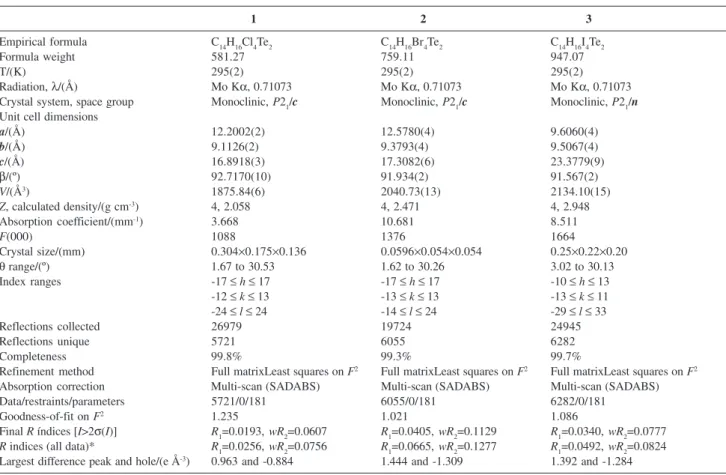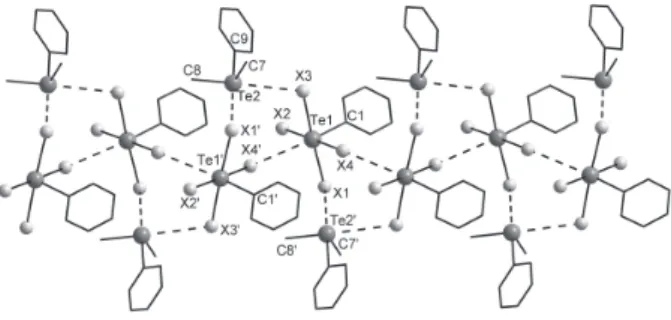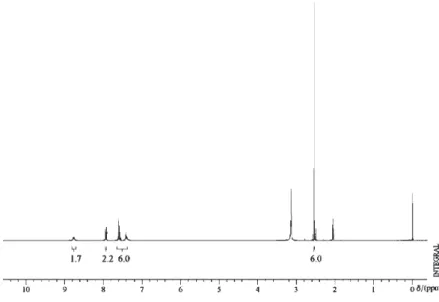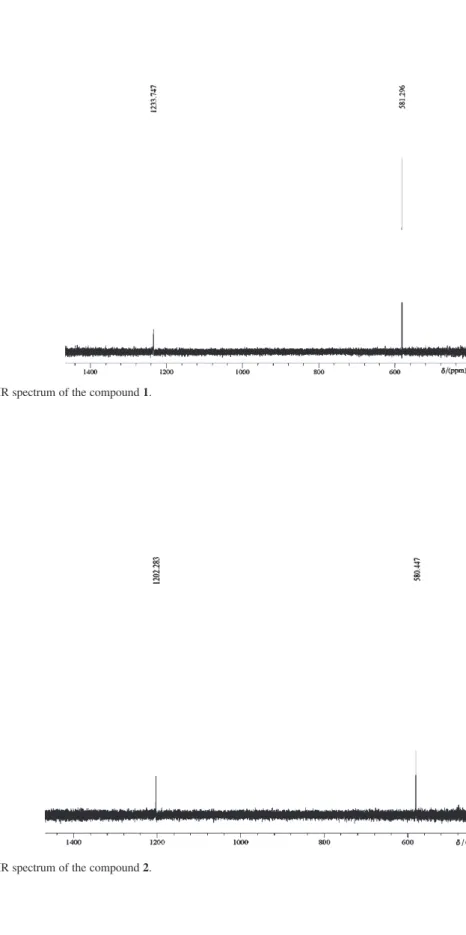0103 - 5053 $6.00+0.00
Article
*e-mail: eslang@quimica.ufsm.br
Synthesis and Crystal Structures of new Complex Salts Containing both Cationic and
Anionic Tellurium(IV) Species: The Role of Secondary Bonds in the Arrangement of
Tellurium Based Tectons
Sailer S. dos Santos, Ernesto S. Lang* and Robert A. Burrow
Laboratório de Materiais Inorgânicos, Departamento de Química, Universidade Federal de Santa Maria, 97105-900 Santa Maria-RS, Brazil
Neste trabalho divulgamos a síntese e a estrutura cristalina de uma série de três novos complexos de telúrio(IV), [Te(C6H5)(CH3)2]][TeX4(C6H5)], X = Cl (1), Br (2) ou I (3). Nesses
complexos, as ligações secundárias promovem diferentes arranjos estruturais, mostrando o caráter tectônico das espécies de telúrio. Em 1 e 2, a interação Te···X promove um arranjo polimérico
na forma de “zig-zag” para os ânions tetra-halofeniltelurato(IV). Em 3, as ligações secundárias
Te···I induzem um arranjo diferenciado para os ânions, que estão organizados de forma antiparalela.
We report herein the synthesis and the crystal structures of three new tellurium(IV) complexes, [Te(C6H5)(CH3)2]][TeX4(C6H5)], X = Cl (1), Br (2), I (3). In these complexes, the
secondary bonds promote different structural arrangements due to the tectonic character of the tellurium species. In 1 and 2, the Te···X interactions create a polymeric “zig-zag” chain of the
tetrahalo-phenyltellurate(IV) anions. In 3, the secondary Te···I bonds induce a different
arrangement for the anions that are organized in a pseudo-dimeric antiparallel fashion.
Keywords: organotellurium halides, tectonic tetrahalo-organyltellurates, secondary bonding
Introduction
Several classes of organyltellurium halide compounds are known, including species of general formula TeX3R, TeX2R2
and TeXR3 (R=alkyl, aryl; X=Cl, Br, I). The solid state
structures of the tellurium(IV) compounds are themselves very interesting owing to the occurrence of secondary tellurium-halogen bonds (Te···X),1 which create exceptional
supramolecular structures, leading to the formation of polymeric chains, dimeric structures, or monomers with fairly strong intermolecular interactions.2-6 We have been interested
for some time in the synthesis and crystal structures of TeX3R compounds and their derivatives, such as the [TeX4R]– anions.
These halogenated tellurates may be considered tectons (any species whose interactions are dominated by particular associative forces that induce the self-assembly of an organized network with specific architectural or functional features7) where the different packing arrangements in the
crystal lattice of [TeX4R]– salts are determined by the
secondary bonds which complete the octahedral coordination
at tellurium. We have already observed this tendency in a great number of examples with cations of alkali metals or
pyridonium and ammonium derivatives.8-11 We now report
the synthesis and crystal structures of [Te(C6H5)
(CH3)2][TeX4(C6H5)], X = Cl (1), Br (2) and I (3), complexes
in which organyltellurium(IV) ion is found in both anionic and cationic species.
Experimental
All reactions were conducted under nitrogen, but recrystallizations of the complexes were done in air.
Methanol was dried with Mg/I2 and acetonitrile with
CaH2, and both were distilled prior to use.12 The
compound iododimethylphenyltellurium(IV) was
prepared according to Reid’s procedure;13 the analogous
chloride and bromide derivatives were prepared by ion exchange with the appropriate silver halide in hot methanol. Trihalophenyltellurium(IV) compounds were
prepared following literature procedures.14 Melting
performed at the Microanalytical Laboratory of the Chemistry Institute – University of São Paulo.
1H and 125Te NMR
The NMR spectral data were obtained in a Varian
Mercury Plus 7.05 T spectrometer with 300.07 MHz (1H)
and 94.74 MHz (125Te). The samples were dissolved in a
9:1 mixture of acetone-d6 and DMSO-d6, respectively. The solutions were measured in NMR tubes of 5 mm, at 300
K. The 1H NMR chemical shifts are relative to Si(CH
3)4
as internal reference. The 125Te NMR spectra were taken
with reference to Te(CH3)2. A capillary containing
Te2(C6H5)2 dissolved in CDCl3 (δ 450) was used as external reference. By convention, the chemical shift is positive when the resonance occurs at higher frequency than that of the reference.
General procedure for the preparation of dimethyl-phenyltellurium(IV) tetrahalophenyltellurates(IV) (general formula [Te(C6H5)(CH3)2][TeX4(C6H5)])
To a solution of 1.3 mmol of TeX3(C6H5),
trihalo-phenyltellurium(IV), in 20 mL of methanol cooled to 0 ºC,
1.3 mmol of TeX(C6H5)(CH3)2,
halodimethylphenyl-tellurium(IV), dissolved in 20 mL of methanol were added dropwise. Precipitation of the desired products occurs immediately. After stirring for 30 min, the powdered products were collected by filtration and recrystallized from acetonitrile.
[Te(C6H5)(CH3)2][TeCl4(C6H5)] (1). Properties: air stable, yellow crystalline substance; C14H16Te2Cl4 (581.30 g mol–1).
Yield: 90% based on TeCl3(C6H5); mp: 158 - 159 °C; C
and H Elemental Analysis: Found (%): C, 29.01; H, 3.25;
Calc. (%): C, 28.92; H, 2.78. 1H NMR (ppm): δ 2.53 (s,
Me), 7.44-8.63 (m, aryl); 125Te NMR (ppm): δ 581.88
(cation), 1234.81 (anion).
[Te(C6H5)(CH3)2][TeBr4(C6H5)] (2). Properties: air stable, orange-reddish crystalline substance; C14H16Te2Br4 (759.10
g mol–1). Yield: 94% based on TeBr
3(C6H5); mp: 125
-126 °C; C and H Elemental Analysis: Found (%): C, 21.74;
H, 2.85; Calc. (%): C, 22.15; H, 2.13. 1H NMR (ppm): δ
2.54 (s, Me), 7.39-8.77 (m, aryl); 125Te NMR (ppm): δ
581.04 (cation), 1203.87 (anion).
[Te(C6H5)(CH3)2][Te(C6H5)I4] (3). Properties: air stable, black crystalline substance; C14H16Te2I4 (947.10 g mol–1).
Yield: 85% based on TeI3(C6H5); mp: 119 - 120 °C; C and H Elemental Analysis: Found (%): C, 17.36; H, 2.22;
Calc. (%): C, 17.75; H, 1.71. 1H NMR (ppm): δ 2.51 (s,
Me), 7.14-8.58 (m, aryl); 125Te NMR (ppm): δ 584.02
(cation), 951.08 (anion).
Crystallography
X-ray data were collected on a Bruker X8 APEX II diffractometer using Mo Kα radiation (0.71073 Å). The crystallographic structures of 1, 2 and 3 were solved by
direct methods (SHELXS-97).15 Refinements were carried
out with the SHELXL–97 package.16 All refinements were
made by full-matrix least-squares on F2 with anisotropic
displacement parameters for all non-hydrogen atoms. Hydrogen atoms were included in the refinement in calculated positions.
Results and Discussion
The new tellurium(IV) complexes were obtained in good yields by the reactions of methanolic solutions of the halodimethylphenyltellurium(IV) with the appropriate trihalophenyltellurium(IV) to afford microcrystalline solids. In order to examine the occurrence and extent of Te···X secondary bonds, and the effect of these interactions on the environment at tellurium atoms, crystallographic analyses were carried out on single crystals of the products obtained from the slow evaporation of acetonitrile solutions. Crystal data and details of the data collection are given in Table 1. Solution NMR spectra confirm the ionic nature of the product.
The solution 125Te NMR spectra show two peaks for
each compound. The low frequency peak, around δ 580, is
attributed to the cationic [Te(C6H5)(CH3)2]+ species, which
corresponds well to the value found for [Te(C6H5)
(CH3)2]I (δ 550 in DMSO).17 The lower field peak, attributed
to the anionic [TeX4Ph]– species, show chemical shifts at δ
1234.81, 1203.87 and 951.08 for 1, 2 and 3 respectively.
The chlorine atom, being the most electronegative of the halides, deshields best the tellurium atom.17
The crystal structures of 1, 2 and 3 confirm that the
bonds are considered for the tellurate anion, the resulting geometry is a distorted octahedron, with the
secondary bond in the trans position to the phenyl
group, forming a structure similar to an equivalent tellurate dianion. Table 2 shows selected primary and secondary bonding distances within the compounds.
The structures of 1 and 2 are isotypic. In these
structures, there are two sets of secondary bonds: one with anion-anion interactions and another with cation-anion
interactions. The first set of secondary bonds is formed by non-reciprocal Te1···X4' interactions between the tellurium atoms and the halogen atoms of the tellurate anions to create a polymeric “zig-zag” chain parallel to
the b crystallographic axis (see Figure 1). In 1, the
Te1···Cl4' distance is 3.4600(1) Å, around 0.350 Å less than the sum of the van der Waals radii; in 2, the Te1···Br4'
distance is 3.5257(1) Å, around 0.384 Å less than the sum of the van der Waals radii. The second set of secondary
Table 2. Selected bond lengths. The covalent bonds are represented by ⎯ and the secondary bonds by ···. Symmetry operations are depicted under the respective columns
1 2 3
Te1⎯C1 = 2.135(2) Te1⎯C1 = 2.145(5) Te1⎯C7 = 2.158(5)
Te1⎯Cl1 = 2.5442(7) Te1⎯Br1 = 2.7239(7) Te1⎯I1 = 2.9712(5)
Te1⎯Cl2 = 2.5003(7) Te1⎯Br2 = 2.7001(7) Te1⎯I2 = 2.9859(5)
Te1⎯Cl3 = 2.5377(7) Te1⎯Br3 = 2.7211(7) Te1⎯I3 = 2.9204(5)
Te1⎯Cl4 = 2.5240(7) Te1⎯Br4 = 2.6906(7) Te1⎯I4 = 2.8845(5)
Te1···Cl4' = 3.4600(1) Te1···Br4' = 3.5257(1) Te1···I2' = 3.7766(1)
Te2⎯C7 = 2.107(3) Te2⎯C7 = 2.099(6) Te2⎯C1 = 2.133(6)
Te2⎯C8 = 2.114(3) Te2⎯C8 = 2.112(7) Te2⎯C2 = 2.103(6)
Te2⎯C9 = 2.113(3) Te2⎯C9 = 2.138(7) Te2⎯C3 = 2.118(6)
Te2···Cl1' = 3.5105(1) Te2···Br1' = 3.6786(1) Te2···I2 = 3.9018(2)
Te2···Cl3 = 3.4477(1) Te2···Br3 = 3.5619(1) Te1···I3'’ = 4.0096(1)
‘= 1-x; -0.5+y; 0.5-z. ‘= 1-x; -0.5+y; 0.5-z. ‘= 1-x, 1-y, -z; ‘’ = x, 1+y, z. Table 1. Crystallographic data of the new complexes synthesized
1 2 3
Empirical formula C14H16Cl4Te2 C14H16Br4Te2 C14H16I4Te2
Formula weight 581.27 759.11 947.07
T/(K) 295(2) 295(2) 295(2)
Radiation, λ/(Å) Mo Kα, 0.71073 Mo Kα, 0.71073 Mo Kα, 0.71073
Crystal system, space group Monoclinic, P21/c Monoclinic, P21/c Monoclinic, P21/n
Unit cell dimensions
a/(Å) 12.2002(2) 12.5780(4) 9.6060(4)
b/(Å) 9.1126(2) 9.3793(4) 9.5067(4)
c/(Å) 16.8918(3) 17.3082(6) 23.3779(9)
β/(º) 92.7170(10) 91.934(2) 91.567(2)
V/(Å3) 1875.84(6) 2040.73(13) 2134.10(15)
Z, calculated density/(g cm-3) 4, 2.058 4, 2.471 4, 2.948
Absorption coefficient/(mm-1) 3.668 10.681 8.511
F(000) 1088 1376 1664
Crystal size/(mm) 0.304×0.175×0.136 0.0596×0.054×0.054 0.25×0.22×0.20
θ range/(º) 1.67 to 30.53 1.62 to 30.26 3.02 to 30.13
Index ranges -17 ≤h≤ 17 -17 ≤h≤ 17 -10 ≤h≤ 13
-12 ≤k≤ 13 -13 ≤k≤ 13 -13 ≤k≤ 11
-24 ≤l ≤ 24 -14 ≤l≤ 24 -29 ≤l≤ 33
Reflections collected 26979 19724 24945
Reflections unique 5721 6055 6282
Completeness 99.8% 99.3% 99.7%
Refinement method Full matrixLeast squares on F2 Full matrixLeast squares on F2 Full matrixLeast squares on F2
Absorption correction Multi-scan (SADABS) Multi-scan (SADABS) Multi-scan (SADABS)
Data/restraints/parameters 5721/0/181 6055/0/181 6282/0/181
Goodness-of-fit on F2 1.235 1.021 1.086
Final R índices [I>2σ(I)] R1=0.0193, wR2=0.0607 R1=0.0405, wR2=0.1129 R1=0.0340, wR2=0.0777
R indices (all data)* R1=0.0256, wR2=0.0756 R1=0.0665, wR2=0.1277 R1=0.0492, wR2=0.0824 Largest difference peak and hole/(e Å-3) 0.963 and -0.884 1.444 and -1.309 1.392 and -1.284
* R1 = |Fo - Fc| / |Fo|; wR2 = [w(Fo2 - F c
2)2/(wF o
bonds are created by Te2···X1’ and Te2···X3 interactions between the tellurium cations and tellurate anions. The tellurium cations are arranged along the polymeric tellurate anionic chain.
The structure of 3 is different from those of 1 and 2.
The strong reciprocal Te···I secondary interactions
between the tellurate anions in 3 form tellurate dimers.
These are united by secondary bonding to the tellurium cations made up from Te1···I2’ and Te1’···I2 interactions to form a polymeric chain in the direction of the
crystallographic b axis (Figure 2). Additional
interactions between the iodide atoms of the tellurate anions, I1···I3 (3.771(1) Å) and I2···I4 (3.859(1) Å), create a lamellar structure perpendicular to the
crystallographic c axis. The tellurate dimers form a
square net into which the tellurium cations pack. Small spaces between the dimers form perpendicular tunnels along the crystallographic a and b axes.
The secondary bonding Te···X exhibited by 1, 2 and 3
in the solid state allow these compounds to be viewed as a supramolecular assembly of tellurium cations and tellurate anions. These three new structures with different architectures confirm the tectonic character of the tellurium
Figure 1. General representation for the structures of 1 and 2, emphasi-zing the zig-zag architecture along the b axis promoted by the secondary bonds Te···X (X=Cl, Br). Symmetry operations to generate equivalent atoms: ‘= 1-x; -0.5+y; 0.5-z.
Figure 2. Representation of the structure of 3, emphasizing the dimeric antiparallel architecture to the anions, promoted by the secondary bonds Te···I. Symmetry operations to generate equivalent atoms: ‘= 1-x, 1-y, -z; ‘’ = x, 1+y, z.
and tellurate ions in which the secondary bonds play a fundamental role in the architecture of the crystal structures.
Supplementary Information
Crystallographic data for the structural analyses have been deposited with the Cambridge Crystallographic Data Centre CCDC nos. CSD 610462, 610463 and 610464 for
compounds 1, 2 and 3. Further details of the crystal
structures investigations are available free of charge via www.ccdc.cam.ac.uk/conts/retrieving.html (or from the CCDC, 12 Union Road, Cambridge CB2 1EZ, UK; fax: +44 1223 336033; e-mail: deposit@ccdc.cam.ac.uk). Proton and Telurium NMR spectra of compounds are available free of charge at http://jbcs.sbq.org.br, as a PDF file.
Acknowledgments
The authors thank Professor S. S. Lemos (UnB) for access to the NMR Varian Mercury Plus spectrometer. The authors gratefully acknowledge financial support from
CNPq, CAPES e FAPERGS via PRONEX and a
scholarship from CNPq (S.S.S.).
References
1. Alcock, N. W.; Adv. Inorg. Chem. Radiochem. 1972, 15, 1. 2. Wynne, K. J.; Person, P. S. ; Inorg. Chem. 1971, 10, 2735. 3. Boyle, P. D.; Godfrey, S. M.; McAuliffe, C. A.; Pritchard, R.
G.; Sheffield, J. M.; Chem. Commun. 1999, 2159.
4. Boyle, P. D.; Cross, W. I.; Godfrey, S. M.; McAuliffe, C. A.; Pritchard, R.G.; Sarwar, S.; Sheffield, J. M.; Angew. Chem.
2000, 112, 1866; ibid. 2000, 39, 1796.
5. Haiduc, I.; Zukerman-Schpector, J.; Phosphorus, Sulfur, Silicon
2001, 171, 73 and references cited therein.
6. Chauhan, A. K. S.; Kumar, A.; Anamika; Srivastava, R. C.; Butcher, R. J.; Beckmann, J.; Duthie, A.; J. Organomet. Chem.
2005, 690, 1350.
7. Simard, S.; Su, D.; Wuest, J. D.; J. Am. Chem. Soc. 1991, 113, 4696.
8. Lang, E. S.; Ledesma, G. N.; Abram, U.; J. Organomet. Chem.
2004, 689, 2092.
9. Lang, E. S.; Fernandes Jr., R. M.; Peppe, C.; Burrow, R. A.; Vázquez-López, E. M.; Z. Anorg. Allg. Chem. 2003, 629, 215. 10. Lang, E. S.; de Oliveira, G. M.; Fernandes Jr., R. M.;
Vázquez-López, E. M.; Inorg. Chem. Comm. 2003, 6, 869.
11. Lang, E. S.; de Oliveira, G. M.; Fernandes Jr., R. M.; Vázquez-López, E. M.; Z. Anorg. Allg. Chem. 2004, 630, 717. 12. Perrin, D. D.; Armarego, W. L. F.; Purification of Laboratory
13. Reid, G.; Hill, N. J.; Levason, W.; Ward, A. J.: J. Organomet. Chem. 2002, 642, 186.
14. Petragnani, N.; Tellurium in Organic Synthesis, Academic Press: London, p. 65, 1994.
15. Sheldrick, G. M.; SHELXS-97, Program for Crystal Structure Solution, University of Göttingen, Germany, 1997.
16. Sheldrick, G. M.; SHELXL-97, Program for Crystal Structure Refinement, University of Göttingen, Germany, 1997. 17. McFarlane, W.; Berry, F. J.; Smith, B. C.; J. Organomet. Chem.
1976, 113, 139.
0103 - 5053 $6.00+0.00
Supplementary Information
*e-mail: eslang@quimica.ufsm.br
Synthesis and Crystal Structures of new Complex Salts Containing both Cationic and
Anionic Tellurium(IV) Species: The Role of Secondary Bonds in the Arrangement of
Tellurium Based Tectons
Sailer S. dos Santos, Ernesto S. Lang* and Robert A. Burrow
Laboratório de Materiais Inorgânicos, Departamento de Química, Universidade Federal de Santa Maria, 97105-900 Santa Maria-RS, Brazil
Figure S1. 1H NMR spectrum of the compound 1.
The NMR spectral data were obtained in a Varian
Mercury Plus 7.05 T spectrometer with 300.07 MHz (1H)
and 94.74 MHz (125Te). The samples were dissolved in a
9:1 mixture of acetone-d6 and DMSO-d6, respectively. The solutions were measured in NMR tubes of 5 mm, at 300
K. The 1H NMR chemical shifts are relative to Si(CH
3)4
as internal reference. The 125Te NMR spectra were taken
with reference to Te(CH3)2. A capillary containing
Figure S2. 1H NMR spectrum of the compound 2.
Figure S4. 125Te NMR spectrum of the compound 1.





